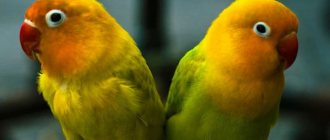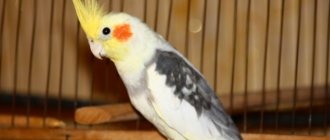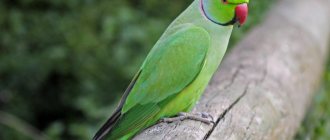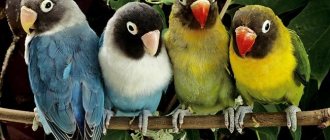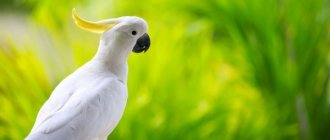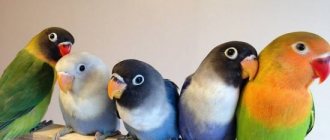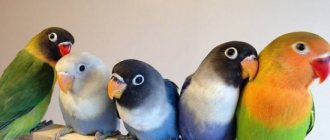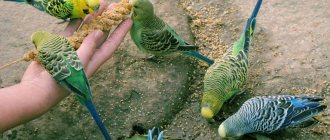Lovebirds (lat. Agapornis) are a genus of birds of the parrot family. These are small parrots up to 17 cm long and weighing 50 grams. In wildlife, the color of the plumage is usually green. These parrots have a massive red beak that can cause serious damage. These cute parrots live in the subtropical forests of Africa and Madagascar.
They got their name from superstition. It is believed that if one dies, then the second dies of longing for him. This may be true, but in captivity lovebirds live quite normally alone.
All about lovebirds
These are flocking birds, however, they are aggressive towards birds of other species and can even attack an individual much larger than themselves. They settle near bodies of water. They sleep in trees, clinging to small twigs with their paws so as not to fall. They eat directly from the branch and do not take food into their paws. They often raid fruit plantations and destroy agricultural plantations. Excellent and they fly a lot. They nest in hollows, empty holes, under roof canopies and in the walls of residential buildings.
Appearance
Lovebirds are small birds with a body length varying depending on the variety and gender from 10 to 17 cm and weighing about 50 grams. The length of the parrot's wing is only 4 cm, and the tail, rounded at the end, is 6 cm. The lovebird has disproportionately short legs relative to the body and a large head. Birds have a powerful curved beak.
Important! In lovebirds, the main feather color is determined by two pairs of unlinked non-allelic genes. This means that in addition to the common green one, you can find white, blue, and yellow parrots.
Types of lovebirds with photos
Lovebirds are divided into 9 subspecies, each of which has its own distinctive features, primarily related to the description of external data.
- Collared (Agapornis swindernianus) - body length 13 cm. A distinctive feature is a collar in the form of an orange thin stripe on a dark neck. The beak is almost black. The breast has a yellowish tint, and the plumage under the tail is blue.
- Masked (Agapornis personatus) - body length 15 cm. The predominant color of the plumage is orange-yellow, but the tail, back, abdomen and wings are green. The beak stands out as a red spot on the brown-black head.
- Red-faced (Agapornis pullarius) - body length 15 cm. Males are green, females have greenish-yellow shades in their plumage. The frontal area, cheeks and throat are colored rich orange-red. Females have a completely orange head.
- Rosy-cheeked (Agapornis roseicollis) - body length 17 cm, while males are smaller than females, but their color is many times more intense. The parrot is olive in color with a bluish tint. The pink on the bird's cheeks and throat gradually turns into deep red on the forehead. The beak is straw-colored.
- Black-cheeked (Agapornis nigrigenis) - body length 14 cm. Similar to masked lovebirds with a difference in the color of the head - it has a grayish tint. An orange-pinkish color is present in the plumage of the upper half of the breast and gradually turns green downwards.
- Blackwings (Agapornis taranta) - body length from 17 cm or more (the largest of the lovebirds). The bird is bottle green in color. The frontal region, eye rims and beak are bright scarlet. The wings are outlined with a black border.
- Grey-headed (Agapornis canus) - body length 14 cm. Green parrot. Starting from the head to the middle of the chest, the color of the male’s plumage is light gray, almost white. In the female, this area is colored grayish-green.
- Lilianas (Agapornis lilianae) - body length 15 cm. They are similar to pink-cheeked lovebirds with the only difference that the head and neck have a more saturated color. The back and wings of the parrot are much darker than the belly and chest. The bird's beak is bright red.
- Fischer's lovebirds (Agapornis fischeri) - body length maximum 15 cm. Yellowish-green parrot with bright golden-orange coloring of the head and neck with brownish splashes. The tail feathers have a blue tint at the end. The beak is red.
Collared
Masked
Red faces
Rosy-cheeked
Black-cheeked
Blackwings
Grey-headed
Liliana's lovebird
Fisher's lovebirds
Lovebirds - why they were called that
It is no coincidence that the birds were called lovebirds. It has long been believed that the male lovebird parrot is monogamous and chooses a mate for himself once and for the rest of his life. If one of the parrots dies, then soon, unable to bear the separation, the other will follow him out of sadness. In practice, everything is different; an orphaned bird can easily build a relationship with a new feathered partner.
What to look for when buying a parrot?
Before purchasing a bird, try to observe it. A healthy bird should have shiny and smooth plumage, without any bald spots. Near the cloaca, the feathers should be dry, the eyes should be clear, the belly should not be swollen, the wax and beak should be dry and clean. It is recommended to choose an active bird.
Lovebirds must be transported to a new place of detention in a cage; in winter, the cage must be placed in a warm bag.
And most importantly, if you are wondering whether it is possible to keep one lovebird at home, then know that these parrots are quite affectionate. Therefore, if you choose a bird that already has a friend next to it, then it is better to take two at once, since when separated, the birds can become very sad and get sick.
In addition, when choosing parrots for home keeping, you need to pay attention to the fact that this species has 9 subspecies that differ in external characteristics, with the most popular being Fischer's lovebird. This bird is no more than 15 cm in size, the plumage is greenish, the rump is blue, the head is orange, the beak is red, there is no gender difference.
Natural habitats
Depending on the species, lovebirds inhabit the forests of the tropics and subtropics; some species prefer mountainous areas and steppe plains.
Geographically, lovebirds live in the southeast, southwest and central Africa, and to be more precise:
- collared - in central Africa and the southwest of the continent;
- masked - in Kenya and on the east African coast in Tanzania;
- red-faced - in Ethiopia, Tanzania, Sao Tome, Sierra Leone;
- rosy-cheeked - in South Africa, Namibia and Angola;
- black-cheeked - in the southwest of Zambia;
- black-winged - in Ethiopian forests and mountains, as well as in northeast Africa;
- grey-headed - on the islands of Madagascar, Zanzibar, Mauritius, in the Seychelles in palm and date plantations;
- Liliana's lovebirds - in the eastern district of Zambia, southern Tanzania and northern Mozambique;
- Fisher's lovebirds - in northern Tanzania.
Social structure and reproduction
Photo: Lovebirds parrots
Lovebirds mate for life. The term lovebird arose from these close connections. They like to be in physical contact as much as possible. They affectionately hug each other and bite with their beaks. This action is similar to a kiss.
Interesting fact: In lovebirds, it is impossible to determine whether an individual is a female or a male. Both sexes of Agapornis look alike and can be confidently differentiated by DNA analysis and by their perching habits. Typically, females sit with their legs further apart than males because the female pelvis is wider.
They nest in hollows, creating rough litter. Females very rarely build nests. The materials used are twigs, pieces of bark, and blades of grass. Different species transport material in different ways: some in their beaks, others by inserting them into the tail feathers, or by inserting them into other parts of the body. As soon as the lovebirds begin to build their nest, mating begins. Females lay eggs in 3-5 days. Before the eggs hatch, the female settles into her nest and sits there for several hours. It happens that even without a nest or male, lovebirds produce eggs.
After the first egg is laid, a new egg will follow every other day until the clutch is complete. Usually there are from 4 to 8 eggs in a clutch. The female does the incubation. After just 3 weeks, the chicks hatch, and the flight from the nest occurs on days 42-56, but the parents continue to care for their offspring.
Character and abilities
The lovebird adapts well to new conditions, quickly gets used to people, and is devoted to its owner. Shy, may die from a broken heart. At the same time, he is curious and cocky. Has a good memory and high intelligence. Finds its cage, responds to its name, and can be trained.
Those who have ever heard lovebirds sing are concerned about how often they do this. After all, the voice of a bird seems unpleasant and loud to most people, but, in truth, it never screams without a reason, and it screams quite rarely.
You can listen to lovebirds singing in this video:
Can a parrot live alone?
Although parrots are called inseparable, they are quite capable of living alone. But since the bird is a flock, the owner must make up for the lack of communication with its feathered relatives. When deciding to place a couple with a parrot, a number of conditions must be met, and there are no guarantees that they will eventually get along.
- Only birds of the same species can get along together.
- More than one pair of lovebirds is not kept in one cage, but it is permissible for the birds to be of the same sex.
- It is better if the parrots are the same age, or the male is slightly older than the female (if the pair is of different sexes), otherwise the mature female may peck the young male to death.
How to tame
It is easier to tame a small parrot born and raised in captivity. It will never be possible to completely tame an adult bird, especially one caught in the wild. Taming occurs gradually, starting with treating the pet with a treat through the bars of the cage, and then on neutral territory until the parrot sits on the owner’s hand.
How to teach to talk
Lovebirds can be taught to speak 10-15 words, provided that the student is isolated from other birds during the entire training. Attempts to teach a pair of lovebirds to talk at once are doomed to failure from the very beginning. Moreover, these parrots are trainable only at an early age - up to 1 month.
It is difficult to become a speaker after a long period of training, so you will have to be patient. You will need to pronounce the same words loudly and clearly with different intonations and do this regularly for quite a long time.
Origin of the species and description
Photo: Lovebirds
One of the most controversial issues among scientists who study the evolution of birds is precisely when modern birds (neornithines) first appeared. This is due to conflicts between fossil recording techniques and molecular dating. The scarcity of parrots in the fossil record, however, creates difficulties, and there are now large numbers of early Cenozoic fossils from the northern hemisphere.
Interesting Fact: Molecular studies indicate that parrots evolved approximately 59 million years ago (range 66–51) in Gondwana. The three main groups of Neotropical parrots evolved around 50 Ma (range 57–41 Ma).
One 15 mm fragment found in sediments at Niobrara was thought to be the oldest fossil ancestor of parrots. However, other studies suggest that this fossil is not from a bird. It is generally accepted that Psittaciformes were present during the Paleogene. They were probably arboreal birds and did not have the specialized crushing beaks of modern species.
Video: Lovebirds
Genomic analysis provides compelling evidence that parrots are a contiguous group with passerines. The first undisputed parrot fossils date from the tropical Eocene. The first ancestor was discovered in the early Eocene formation in Denmark and dated to 54 million years ago. It was named Psittaciformes. Several fairly complete skeletons similar to parrots were discovered in England and Germany. These are probably not transitional fossils between ancestral and modern parrots, but rather lineages that evolved parallel to parrots and cockatoos.
Purchase and prices for lovebirds
It is better to purchase a lovebird from an experienced breeder. When choosing a pet, first of all, pay attention to the appearance of the parrot and its activity - the main indicators of health.
If the parrot is young, then its color will not be very bright - this is normal. Six months later, when the first moult of lovebirds takes place, their plumage will become more saturated colors.
Pink-cheeked lovebirds are more popular for keeping at home. The price per individual will not exceed 2.5-3 thousand rubles. Fischer and masked parrots will cost a little more.
Compatibility of lovebirds with other poultry and animals
It is better to keep only representatives of one species in a cage. They do not get along well with other animals. They attack, scream and may even pinch representatives of other species.
It is not recommended to hang a mirror in a cage. One of the pair can perceive the reflection as another parrot and take care of it. Some birds even fall in love with the reflection, and then, not receiving reciprocity, fall into melancholy.
Keeping at home
It is easy to cope with the task of how to properly care for lovebirds if you comply with a number of conditions:
- maintain the air temperature in the room with the feathered pet at 20-25⁰С;
- Avoid drafts, excessive humidity or dry air. Install a humidifier and maintain humidity at 50-60%;
- take the cage with the parrots out into the fresh air in the warm season;
- the bird must sleep for 15 hours, so in the summer the cage must be covered with a cape at night, shortening the daylight hours.
How do lovebirds sleep in winter, when night takes up most of the day? For parrots, the number of hours of sleep and wakefulness should remain unchanged. To do this, you need to install a UV lamp at a distance of 1 m from the cage - a source of additional lighting.
Arrangement of the cage
For one lovebird, a cage with dimensions from 80x30x40 cm is suitable. Keeping lovebirds in pairs means a larger house - from 100x40x50 cm or more. The cage should be square or rectangular in shape. Suitable materials of manufacture are nickel, plexiglass and plastic. The minimum distance between the rods is 1.5 cm. It is advisable that the cage be equipped with a retractable tray.
A layer of sawdust or river sand, previously calcined in the oven, is poured onto the bottom of the cage. In addition, the cage contains:
- 2 feeders and 1 drinker per individual;
- wooden perches with a diameter of 1.5 to 2 cm each;
- toys for lovebirds: ropes, swings, ladders, rings, etc.
Diet
The basis for feeding a lovebird at home is grain mixtures (the norm is 1-2 tbsp per day). You can buy a ready-made grain mix from imported manufacturers or prepare it yourself from the following ingredients:
- cereals,
- oat grains,
- crushed corn,
- millet,
- canary seed,
- sunflower seeds,
- dried fruits and nuts (optional in minimal dosage).
In addition, parrots are offered fresh vegetables, fruits, berries and herbs every day. Animal products: low-fat cottage cheese and a hard-boiled egg are given once a week. A lovebird can sharpen its beak with the help of fruit branches. Also, chalk, charcoal or activated carbon should always be freely available.
Important! Lovebirds should not eat avocados, mangoes and persimmons, candied berries, sweet and fried foods, coffee and alcohol.
Grain feed is poured into the feeder in the evening, the entire daily requirement at once. Feeding with vegetables and fruits is carried out in the morning. They are placed in a separate feeder, replaced with fresh ones during the day, and the remains are completely removed at night.
Care and hygiene
Care that has a beneficial effect on the life of lovebirds at home includes, among other things, mandatory hygiene procedures. Every week, the cage, perches and toys are washed with hot soapy water, doused with boiling water and dried thoroughly. Feeders are cleaned daily immediately before being filled with fresh food and water.
Regarding how to wash the lovebird itself (which is very important for its harmonious development and maintenance of health): daily in the summer and twice a week in the winter.
The bird bathes either in a separate bathing suit filled with clean water without soap to a depth of 2 cm, or in a sink under the tap. The optimal water temperature for swimming is 27⁰C.
Temperature for keeping lovebirds
The room in which you plan to house the parrot should be bright, warm, and clean. It also needs good ventilation, but no drafts. The gentle lovebird needs moist air without temperature changes. In a stuffy, dry room, parrots begin to lose their feathers. But excessive dampness is even worse for birds than dry coolness.
It is advisable to maintain the indoor microclimate parameters at an average level:
- relative air humidity 50 – 60%;
- temperature 23 – 25 degrees Celsius;
- natural light, supplemented by a lamp in winter.
The permanent location of the cage should not be near windows or heating radiators. In hot weather, lovebirds can overheat under the bright rays of the sun. Hot radiators dry out the air, so it is recommended to use a humidifier. You cannot place the cage on the floor: it is cooler there, there is a danger of drafts and attacks by domestic animals. It makes the most sense to mount it on a shelf or hang it in the corner of the room at eye level.
Reproduction at home
The summer and first autumn months are considered favorable times for mating, although lovebirds that have reached the age of one can breed all year round. Before mating, lovebirds create favorable conditions for the couple: they are intensively fed protein foods, and daylight hours are artificially increased to 14-15 hours.
The nesting house is placed in the cage after half a month, and thin twigs are also placed from which the female will build a nest. There she will lay 4-8 eggs, after 20 days they will hatch into naked, blind and deaf chicks. After 10 days, the lovebirds will open their eyes, in a month they will fledge and in another week they will leave the nesting house. Parents will feed the babies for 2 months, after which the parrots can be resettled.
How to determine gender and age
You can determine the sex of birds by judging by how lovebirds look, that is, by external signs depending on the species, and also by knowing some tricks:
- if you look at the parrot in profile, the male’s head seems more elongated and flat;
- the female is more active and talkative than the male;
- If you throw a piece of paper into a bird's cage, the male will be indifferent to it, but the female will begin to tear off small pieces and stuff them under her tail. This is how she makes provisions for the future nest.
The size of adult individuals does not differ from younger ones, so age cannot be determined using this parameter. But there are ways here too:
- in chicks up to 6 months old, green feathers have a grayish tint, which disappears as they grow older;
- the skin over the beak of parrots up to 3 months of age is dark in color;
- babies have lighter and smoother paws, which become covered with more and more dark scales as they age;
- in the first few months, lovebirds have enlarged pupils and almost completely cover the whites of the eyes;
- up to 3 months, parrots have impaired balance, they fly poorly.
You will learn a few more tips on how to determine the sex of lovebirds from this video:
Selecting a cage and accessories
The bird spends most of its life inside the cage, so you need to pay special attention to choosing a future home. The main requirement is safety. The cage must be made of durable material that is resistant to damage. Lovebirds have a strong beak, which they use to chew on everything around them. If the rods contain copper or zinc, such a house can harm your pet and cause poisoning.
Briefly about the parameters of the home for lovebirds:
- steel frame;
- rectangular shape;
- sizes 40 / 50 / 80 cm;
- arrangement of rods 1 - 1.5 cm;
- retractable or removable tray;
- door with a secure bolt.
The range of cages for keeping birds is now so rich that it is not surprising to make a mistake by succumbing to the first impression. The optimal option is one with a nickel-plated cage, complemented by parts made of plastic and organic glass.
To properly care for fragile feathered pets, you need the following accessories:
- Wooden perches. Lovebirds wear down their rapidly growing claws using perches. The diameter of the perch should be such that when sitting the parrot does not completely encircle it with its paws. Plastic products are less preferable because they can cause corns.
- Feeders and sippy cups. For water, it is preferable to have an automatic drinker. Feeders are attached to the rods away from the perches and drinking bowl so that droppings and water do not get into the food.
- Ropes, ladders, swings. These are not essential items, but they will diversify the parrot’s leisure time and help pass the time. How else are such accessories useful? The lovebird climbs ropes made of natural fibers, clings to the ropes, and the overgrown horny edges of the beak and claws are erased.
Place equipment in the cage taking into account the needs of the birds: do not clutter the space with unnecessary items. Leave room for free movement and jumping. The size of their body, lovebirds are similar to starlings, but even such small birds want to shake their wings and stretch.
Diseases and prevention
The most common diseases in parrots in captivity include:
- infectious diseases,
- damage by ticks and lice eaters,
- helminthic infestation,
- avitaminosis,
- obesity,
- gout,
- poisoning,
- incessant shedding,
- bruises, dislocations, fractures, etc.
The weak point of lovebirds is their eyes. Thus, swelling of the eyelids and eye injuries without proper treatment lead to complications, including blindness. What to do if a lovebird has the initial stage of glaucoma - only a veterinarian can determine; it is unacceptable to engage in independent treatment.
To prevent a number of dangerous diseases, lovebird chicks at the age of 2 months must be vaccinated and revaccinated every month until the birds reach 5 months of age. At 6 months, you can vaccinate your parrot against rabies for the first time, followed by booster vaccinations according to schedule.
Vaccination
When kept in a nursery, lovebird chicks are vaccinated against a number of diseases: killed pathogen viruses are combined in one vaccine. Once in the body, the serum promotes the formation of antibodies. According to the vaccination schedule, the first vaccination is given to chicks at the age of 60 days, when the immunity received from the mother weakens. Booster vaccinations are given every 3 to 4 weeks until the age of 5 months.
When the lovebird reaches six months of age, he can be vaccinated against rabies. Preparation for manipulation is the same as for humans: the parrot must be healthy, with normal body temperature. Vaccinations will not provide immunity for life; revaccinations will be required at regular intervals.
Small lovebirds are an excellent option for keeping at home, because caring for them is quite simple. Without special expenses, you get cheerful, sociable companions. These are ideal pets.
Life expectancy, causes of death
Not a single individual of this species will live in natural conditions as long as lovebirds live with proper care at home - and this is no less than about 15 years, and sometimes more. In the wild, the bird's life expectancy is limited to a maximum of 10 years due to lack of food and water during drought, difficult flights, defending its territories in fights, attacks by predators and the mass extermination of parrots by farmers.
Diet
The diet of lovebirds must be clearly balanced; it should be based on food from a mixture of grains with mandatory dilution with herbs and fruits, as well as vegetables. It is necessary to clearly monitor the presence of:
- fats;
- vitamins;
- carbohydrates;
- proteins;
- microelements.
It is important to count grain mixtures at approximately 60% of the total parrot food ration. The content of the grain base is rich in the following components:
- carotene;
- phosphorus;
- iron;
- proteins;
- copper.
It is very useful to dilute food from grain mixtures with grated carrots, or beets. Separately, you need to give the birds sunflower seeds, their amount must be calculated at approximately 15% of the total weight of the feed to maintain stable health of the birds. Among other things, oats should be given separately, the rate of which should be kept within 35% of the total amount of feed.
Owner reviews
Lovebirds, judging by the reviews of their owners, live up to their name and absolutely cannot be left alone for a long time. They can be kept company by either a feathered comrade or girlfriend, or a human.
For those who are not ready to keep a couple of birds at once and do not have an impressive amount of free time to devote to their pet, you can consider buying a budgie or a cockatiel instead of a lovebird. These varieties are much calmer about loneliness. Otherwise, lovebirds will not cause any trouble; they are unpretentious in care and food, friendly, cheerful and sociable.
Floor
If you plan to keep a pair, you still buy a male first. When he gets used to it, you can choose a girl who will immediately be placed in his cage.
If you do it differently and place a boy with an already tamed female, they are unlikely to be able to become friends, because birds have a matriarchy. Females will spread rot and knock the guest. They can even maim and kill. They are much stronger and larger than males.
Which gender is preferable?
Appearance
Many bird lovers are interested in the question of what a lovebird looks like. The bright color is dominated by green. Saturation of tone appears at six months of age. Individual areas (chest, neck, tail, head) are colored blue, pink, yellow and red.
The length of the body of lovebirds is 10-17, the wing is 4, the tail is 6 cm. They have a curved and strong beak, which is mainly yellow and red. Birds have a relatively large head and short legs.
Why was it called that?
When purchasing, potential buyers often ask the question: why are lovebirds called that? There is a legend that these birds choose a mate once in their life. A special relationship develops between the female and the male. They love spending time together. The male brings food to his friend and preens her feathers.
This is interesting! In fact, they can live without their other half. You can also give an orphaned parrot a new pair.
